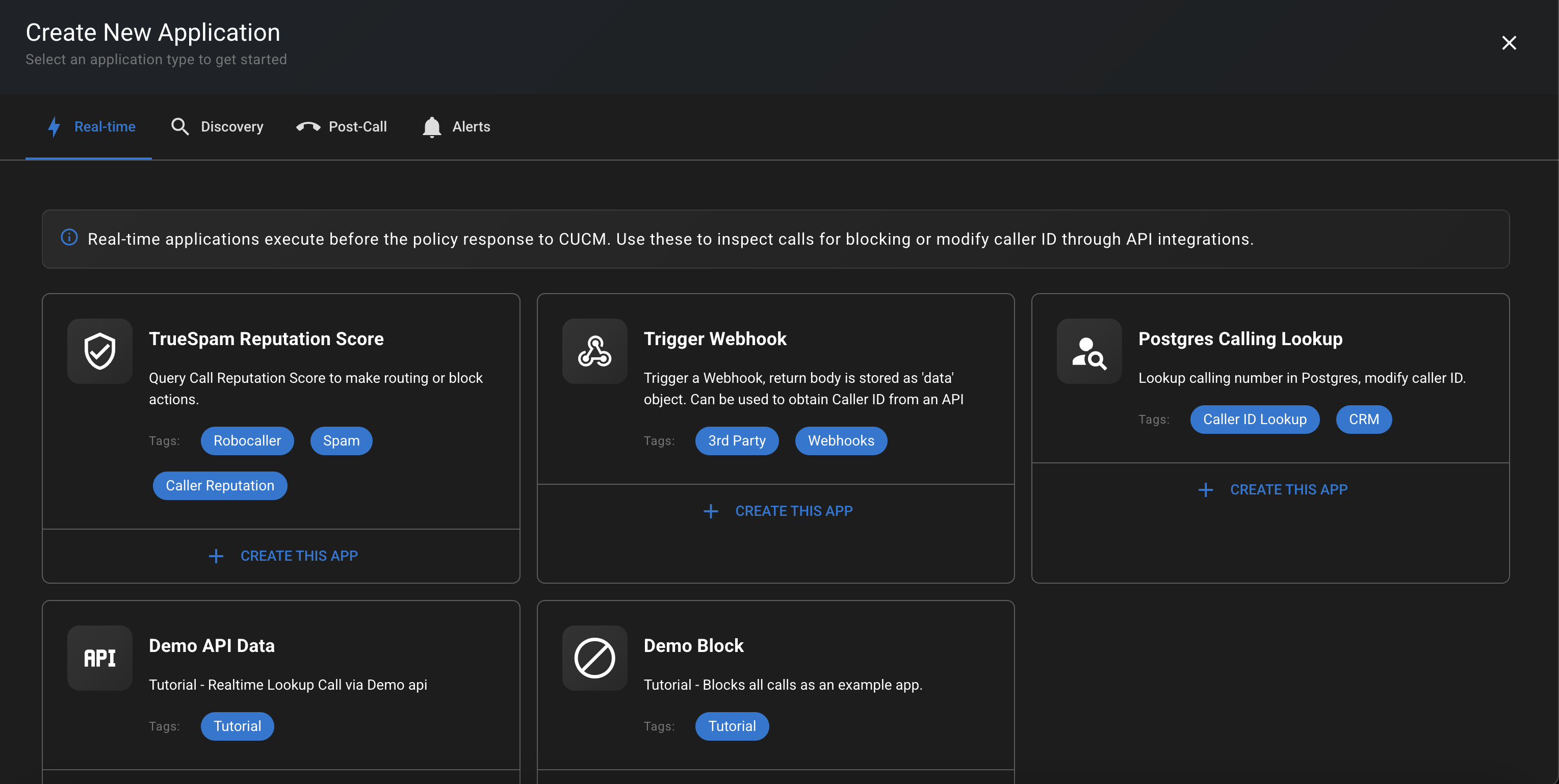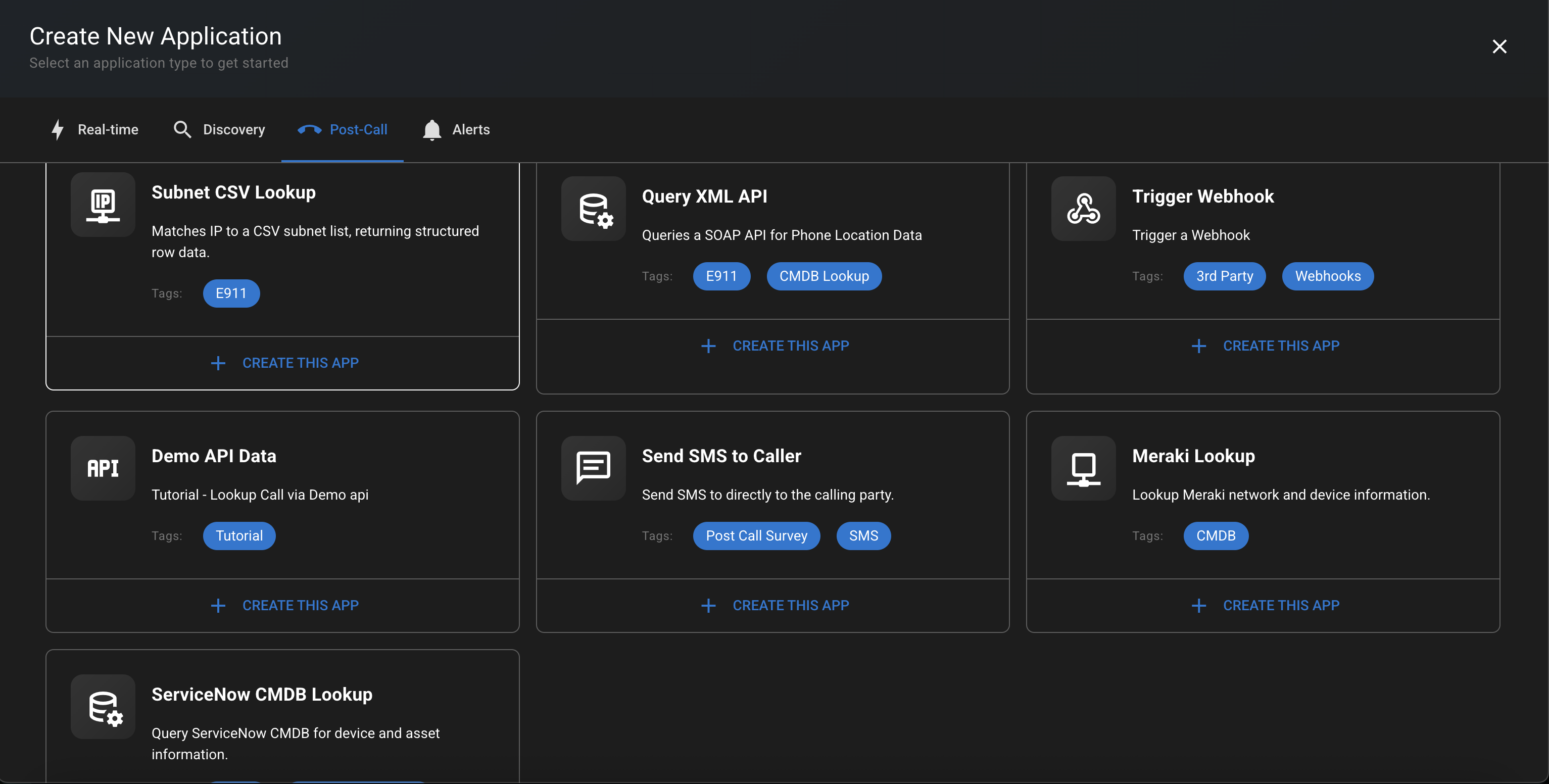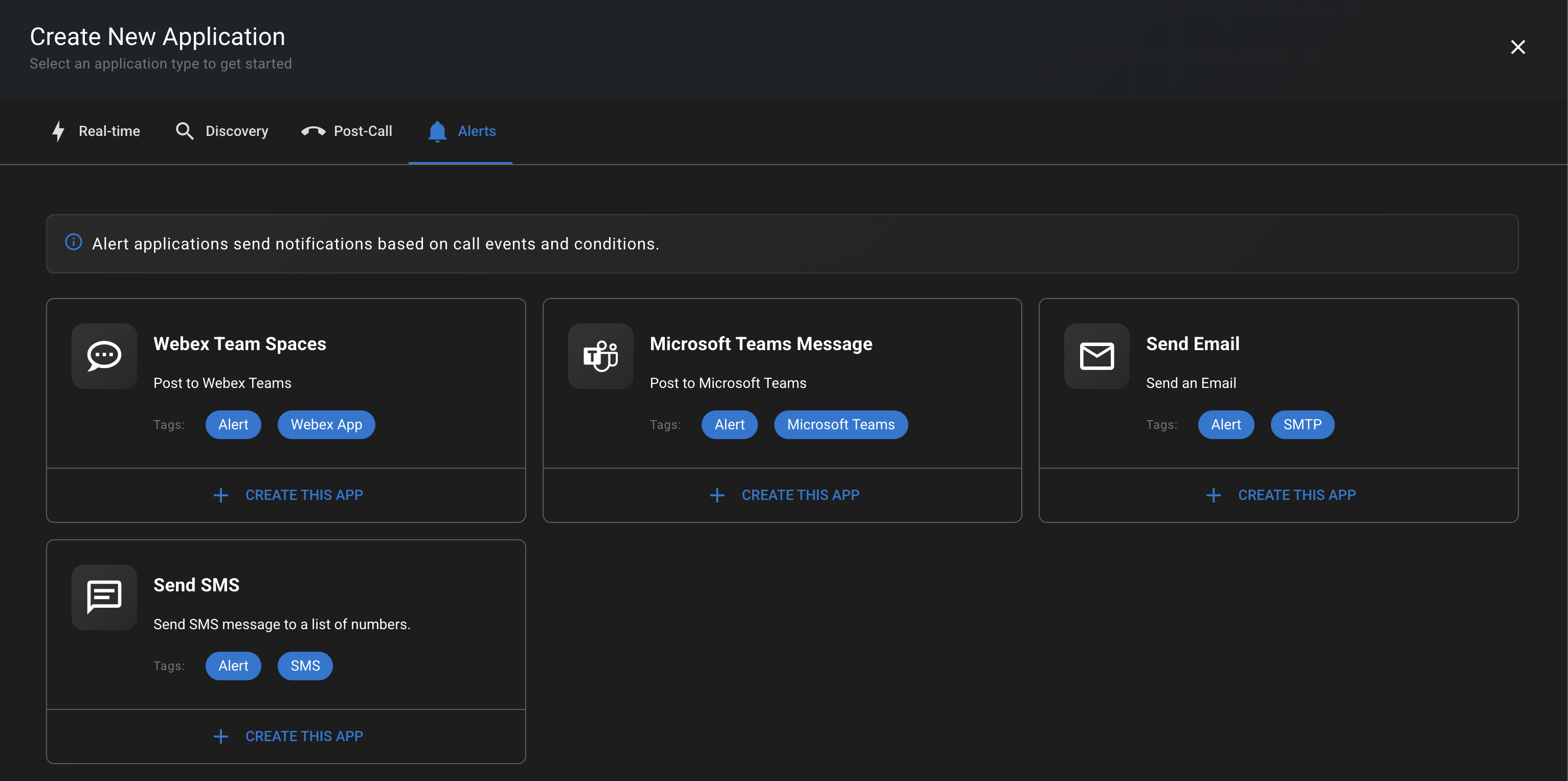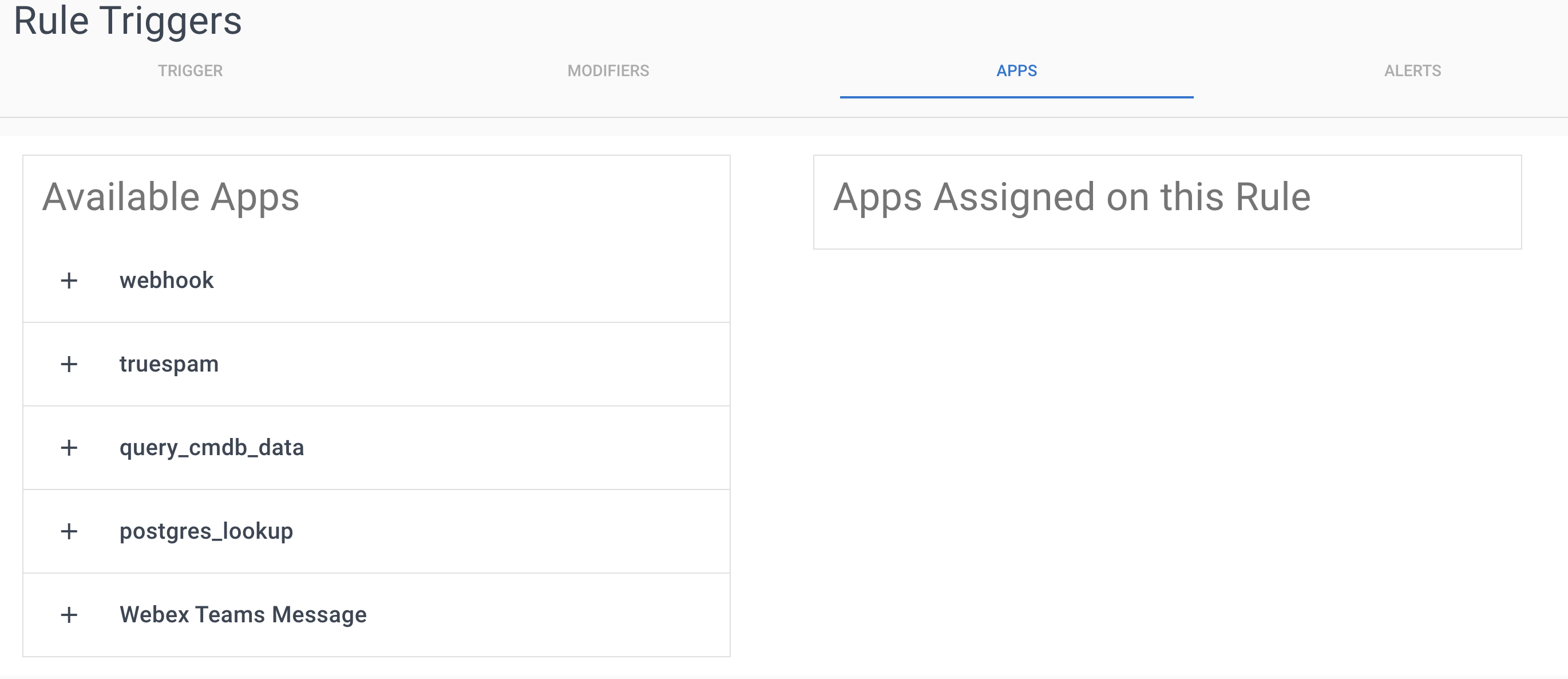Appearance
Call Telemetry Apps - Extend Your Cisco Phone System
Overview
Call Telemetry Apps extend Cisco CallManager's capabilities by integrating with external systems and automating workflows. Apps can modify caller ID, block spam calls, track emergency locations, and send automated notifications - all triggered by incoming call events.
Apps work by intercepting call events through the CURRI API and executing custom logic. You can chain multiple apps together to create powerful call handling workflows.

Discovery Apps

Post Call Apps

Alerting Apps

Feature Requirements
- Call Telemetry Server Appliance
- Call Telemetry Premium or Demo License
- Cisco Callmanager 8.5 with CURRI Integration to Call Telemetry
- Configured External Call Control Profile Inspection - A route pattern, translation pattern, or phone extension must be enabled for Call Telemetry Policy inspection.
Getting Started with Apps
- Navigate to Apps: From the sidebar, click Policies → Apps
- Choose App Type: Select from the available app catalog
- Configure the App: Each app has specific configuration requirements
- Associate with Rules: Apps must be associated with policy rules to execute
- Test Your Workflow: Use Call Tests to validate app behavior
Realtime vs Post Call Apps
Apps are workflows that are triggered by the incoming call event over the CURRI API.
There are two types of Apps that can be created:
- Realtime Apps - These Apps run before the call, to modify call properties, or change call routing based on API responses.
- Post Call Apps - These Apps run after the call, and can exchange data with APIs, compose and send alerts.
Apps Sequence Diagram
Let's visualize the sequence of events when a call hits a Policy, and the Apps run. You can see below, how Realtime Apps are responsible for changing the callflow - before the call is routed. Post Call Apps are responsible for sending data to APIs - after the call has completed.
Realtime Apps - Actions before the call is routed
Realtime Apps are triggered by Cisco CURRI API events from External Call Control Profile Policies. In Call Telemetry terms, the calls hit a Policy, then a Rule matches, and the Rule's Apps will run before the call is routed.
Realtime Apps modify call routing decisions before the call connects.
Realtime Apps can influence call routing
Apps can request actions to the policy, changing the default "permit" to other actions:
- Block the caller
- Rename or Change the Caller ID or Name
- Redirect or Send the caller to Voicemail
- Play a Cisco Callmanager Greeting or Announcement - Greeting Injection
Realtime Apps available
- TrueSpam Scoring
- This App queries the TrueSpam API, and returns a risk score from 0-100. The App can then take actions based on the score, like block, rename, or redirect the call.
- Webhook CRM App
- This App queries a JSON API, and can change the callflow based on the data returned. For example, you could query a CRM API for the caller's name, and replace the caller ID name with the CRM name.
- PostgreSQL CRM App
- This App queries a PostgreSQL database, and can change the callflow based on the data returned. For example, you could query a custom database for the caller's name, and replace the caller ID name with the database name.
- Demo API App
- A simple tutorial app for testing your Call Telemetry infrastructure. Returns static data to validate app pipeline functionality.
Post Call Apps - Actions after the call is routed
Post Call Apps are also triggered by Cisco CURRI API events triggered External Call Control Profile Policies. In Call Telemetry terms, the calls hit a Policy, then a Rule matches, and the Rule's Apps will run after the call is routed.
Apps for post call processing
- Cisco IP Phone Discovery
- Gathers AXL, RIS, CDP, Subnet, and Traceroute information about a phone for use in alerts or other apps.
- E911 Subnet Location CSV
- Compares the Subnet discovered from the Phone to a CSV list, with optional data fields adding more context. List can be downloaded per schedule.
- Meraki Lookup
- Discovers phone locations using Cisco Meraki Dashboard integration. Finds connected switches, ports, VLANs, and physical addresses for E911 and network troubleshooting.
- SOAP Query CMDB App
- Queries CMDB systems via SOAP/XML for detailed location information based on switch name, port, or other discovered data. Works with HP Service Manager, ServiceNow, BMC Helix, and other SOAP-based CMDBs. Perfect for E911 dispatchable location.
- ServiceNow CMDB Lookup
- Native ServiceNow integration for asset and location discovery. Queries CMDB tables for device information, automatically follows location references, and provides comprehensive asset data for E911 and IT operations.
- Webhook App
- Integrates with any REST API for post-call analytics, CRM updates, and notifications. Send call data to external systems after calls complete.
- Send a Message via Webex Teams Bot
- Posts messages to Webex Teams spaces for real-time collaboration alerts. Perfect for emergency notifications, security incidents, and team coordination.
- Twilio SMS
- Sends automated SMS alerts to multiple recipients when specific call events occur. Perfect for emergency notifications, fraud alerts, and on-call escalations.
- Send a Message via SMTP
- Sends a message to a list of email addresses via SMTP
- Twilio SMS to Caller
- Sends SMS messages directly to the calling party after calls complete. Perfect for satisfaction surveys, appointment confirmations, and follow-up information.
Associating Apps to Rules
Apps are global objects, and you must create an App before they will show up for use in Rules.
Pressing the '+' button will associate the App to the rule. Pressing the '-' button will remove it from the rule.
If the rule matches, the Apps are executed in the order specified, from 0 to 100.

Common Use Cases
CRM Integration for Better Customer Service
- Use the Webhook or PostgreSQL apps to lookup customer information
- Display customer name and account details on agent phones
- Route VIP customers to specialized queues
E911 Emergency Response
- Phone Discovery App identifies caller location
- SOAP Query App retrieves detailed CMDB location data
- Subnet CSV App provides building/floor details
- SMS/Email apps notify security teams instantly
Spam Call Protection with TrueSpam
- TrueSpam API integration provides caller reputation scores (0-100)
- Automatically block calls scoring above your threshold (e.g., 80+ for high spam risk)
- Rename caller ID with warning prefix for medium-risk calls (e.g., "SPAM: ")
- Redirect suspicious calls to voicemail or IVR
Multi-App Workflows
Example: Emergency call workflow
- Phone Discovery App → Gathers phone location data
- SOAP Query App → Queries CMDB for precise room location
- Subnet CSV App → Provides building/floor fallback
- SMS App → Notifies security team
- Email App → Sends detailed report to facilities
Custom Development
- Contact me for custom app development.
